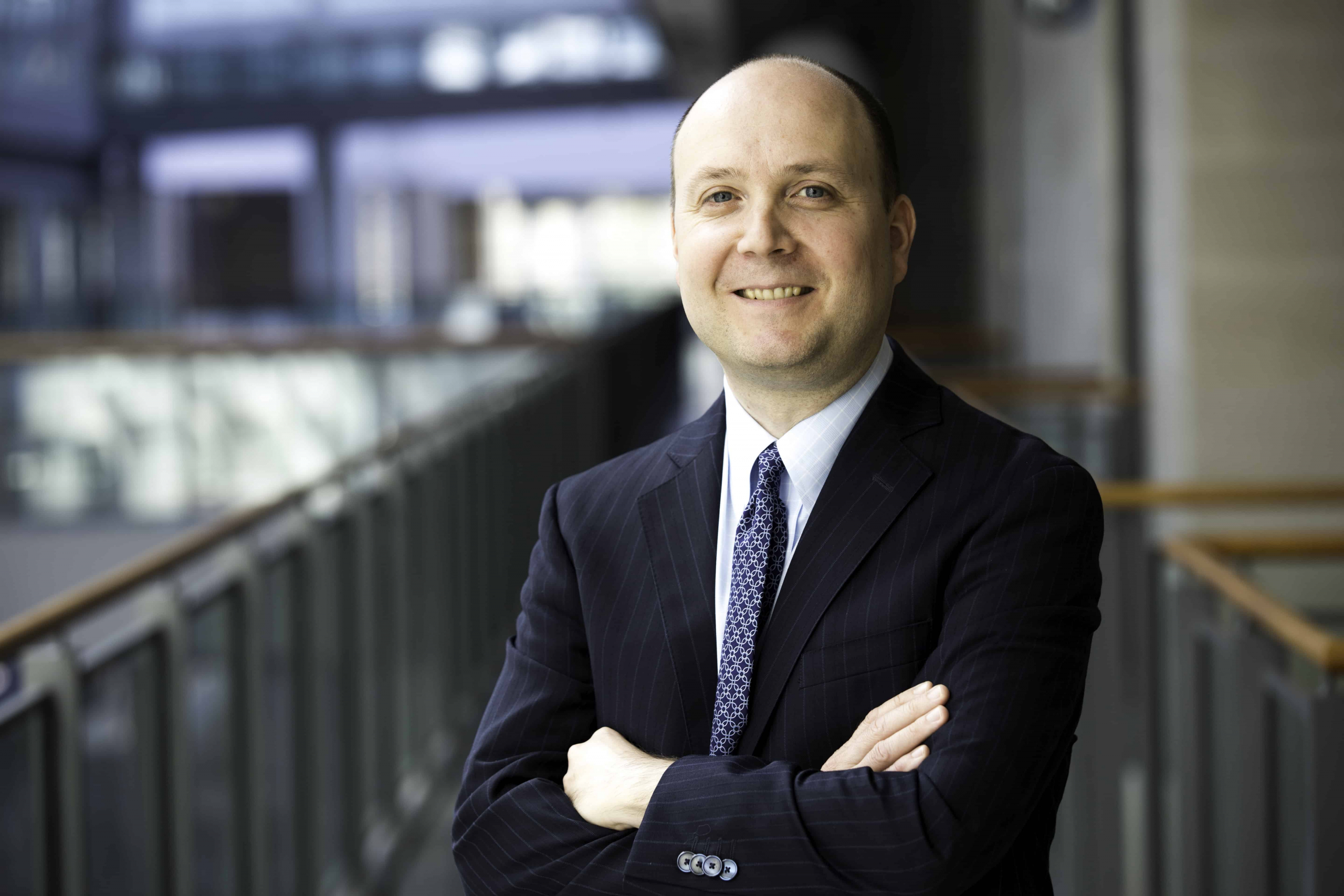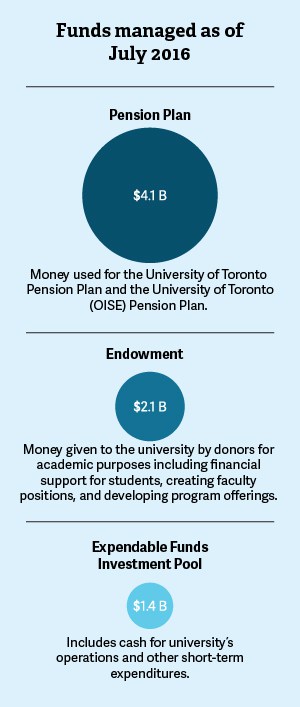Daren Smith’s new job as U of T’s chief money manager is unparalleled in Ontario. Last year, Smith’s predecessor brought in the second highest public sector salary in the province.
Chartered Financial Analyst William Moriarty acted as President and CEO of the University of Toronto Asset Management corporation (UTAM) for eight years. In 2015, he was paid a handsome sum of $1,473,445.98; he then retired in April 2016.
Smith assumed the role on September 1, under the slightly altered title, ‘President and Chief Investment Officer.’ The title change is a distinction without a difference though; his new job is to lead UTAM as a business and as an investment manager.
The UTAM office is housed in the heritage building at MaRS Discovery District, an institution well known for existing at the nexus of the public and private sector. It is a fitting location for the corporation, whose sole client — the University of Toronto — is also its owner.
UTAM was established in 2000 to oversee the management of three University of Toronto funds: the Long-term Capital Appreciation Pool (LTCAP), which includes the university’s endowment; the university’s pension funds; and the Expendable Funds Investment Pool (EFIP), which is used for operations costs and other short-term expenses.
The UTAM team does not form investment portfolios from their office at MaRS but instead hires various external portfolio managers who they believe will deliver high returns.
Universities in Ontario usually leave the management of their investments to governance committees and staff members. No other university in Ontario owns a separate not-for-profit corporation for this purpose, making UTAM unique.
A costly endeavour, in 2015, the top six paid UTAM employees earned $4,330,616.06 collectively — about $800,000 more than what the university’s president and 11 vice presidents earned altogether. This compensation figure does not include any of the fees paid to portfolio managers, which can also be high.
At the same time, U of T stands apart from other Ontario universities in the sheer size of its assets. About $7.9 billion is currently managed by UTAM, with $2.1 billion of that amount comprising the university’s endowment. By comparison, Queen’s University has an endowment of $912 million, and that of the University of Western Ontario (UWO) is valued at $586 million, according to the universities’ most recent reports.
Tucked away off the boundary of UTSG and in the fine print of U of T’s financial reporting, UTAM seldom draws the attention of student groups. Two weeks after Smith assumed the corporation’s top job, The Varsity sat down with him to discuss many of the considerations that accompany managing $7.9 billion on behalf of a university.
Beyond divestment, ethical investing
In late March 2016, U of T President Meric Gertler rejected the recommendations of the Presidential Advisory Committee on Divestment from Fossil Fuels to divest from companies complicit in climate change and released the report Beyond Divestment: Taking Decisive Action on Climate Change.
This turned out to be a decisive moment for UTAM, which received news of Moriarty’s departure around the same time. The report called on UTAM to implement environmental, social, and governance (ESG) factors in their investing, a term used widely by ethical investment groups such as the United Nations Principles for Responsible Investing (UNPRI).
“We’re still doing a lot of research in terms of figuring out what best practices are and what makes sense,” Smith explained, when asked about UTAM’s progress on the President’s report. “I’d say we’re still in the mid stages of that journey.”
He acknowledged that UTAM missed the July 1 deadline that Gertler set for the development of principles related to ESG factors, citing the leadership change as a reason for the delay. “One of the things we’re actively working on now is a way to score our portfolio. So we need to know what we’ve got as a starting point,” Smith explained.
This may involve signing onto UNPRI, something that Gertler called for in his report, and enlisting the services of a third-party data provider, such as MSEI, to provide a framework for “scoring” UTAM’s holdings. Smith hopes that such a framework will be established within three months.
After that, the actions that UTAM will take are undetermined. “Everything is potentially on the table and we just want to make sure that we do our homework,” Smith said.
Despite the delay, Gertler is optimistic about UTAM’s progress and leadership under Smith. He pointed out that the pension committee — the committee within the Governing Council that is responsible for policies surrounding the pension — has implemented ESG considerations into its investment policies. “That is a change that I think will be mirrored in the work that UTAM will be doing, with regard to the endowment portion of the investment,” he said.
UTAM regularly discloses a list of its segregated funds that exceed $1 million. Many energy and materials companies are included in the most recent version of the list, released in June 2016, including ones with interests in Alberta’s oil sands. Lockheed Martin Corp is also on the list, a company from which the Boycott, Divestment, and Sanctions group on campus has long called for divestment, citing the company’s involvement in the Israeli military’s activities in the Palestinian Territories.
“The bottom line is that most of our investments that are disclosed are within the Canadian Equity portfolio,” Smith explained, “and the Canadian Equity Portfolio or the Canadian Equity markets, as you may know, have a very significant allocation to energy and materials including mining.”
While Smith indicated that he has not looked into the list in great enough detail to determine a level of concern for particular investments, he said that ESG considerations should apply to all of UTAM’s holdings, including segregated and pooled funds, and those that are not regularly disclosed.
Performance, not just for show
“Look, in the investment industry, there are no guarantees here,” Smith said. “But we think you do need skilled investment professionals in order to increase the likelihood of creating value.”
As Smith sees it, this process, which includes hiring expensive investment professionals, is working. “The bottom line is I think the last five years have been quite strong in terms of performance and you know we’re hoping that we can continue that going forward,” he said.
Smith measures UTAM’s performance against two main metrics, both of which are set by the university: the reference portfolio and target returns.
“The reference portfolio, it’s a passive portfolio, it’s easy to implement. Over the very long term the expectation is that that should be able to meet the university’s risk and return objectives.” Simply put, UTAM is attempting to outperform this portfolio, net of costs.
“I do think that over the long term, if we can’t outperform that benchmark portfolio — I also refer to it as the reference portfolio, they’re interchangeable — then we shouldn’t be in business,” Smith said.
On this measure, both Smith and Gertler report success, pointing to the figure that, over the last five years, UTAM has outperformed the reference portfolio by almost two per cent. “That represents hundreds of millions of dollars of new value added to both the pension plan and the endowment combined,” Smith said.
Factoring in the target returns over time, however, paints a less sunny picture of UTAM’s achievements. Over the last 10 years, while the LTCAP and the pension fund have outperformed the reference portfolio by 0.29 per cent and 0.24 per cent respectively, they missed the target return by -1.44 per cent and -1.56 per cent.
Given that, as Gertler emphasized, these reports are net of costs, the fact that UTAM has outperformed the reference seems to indicate that the company is adding value to U of T’s funds over time.
“You want to make sure that, ultimately, UTAM is able to deliver good performance and good value over a sustained period of time,” Gertler said.
Gertler also noted that the university is prudent at comparing UTAM’s operations to others managing similar-sized funds, to ensure its value to the university. “So we do that on an annual basis just to sort of make sure that our compensation rates are in line with other operations. And generally, ours are actually a little bit lower in terms of the base salaries that our managers receive, but there’s a little bit higher performance based component to their compensation.” To find comparable operations, Gertler said, it is necessary to look south of the border.
In terms of performance metrics, Smith says that it is not useful to compare UTAM to Ontario universities. “It’s difficult if you just look at the end number from different institutions because their starting point is going to be different,” he said, referring to the fact that different universities are bound to have differing benchmarks and risk tolerances.
When asked about the fact that, as of 2015, U of T and UWO had nearly identical five-year return rates on their endowments at just above ten per cent, Smith said that this comparison neglected an important part of the picture. “If you want to do a fair comparison I think you need to say, ‘Okay, how did they actually do versus their benchmark?’ I’d be surprised if over the last five years they’d outperformed by a similar magnitude.”
UWO sets benchmarks for each of its individually-hired managers rather than comparing its entire investment pool to a singular reference portfolio. The risk tolerance of both schools is not so far apart: UWO expects a standard deviation in returns of 11.7 per cent, while U of T targets a standard deviation of 10 per cent or less.
Investment returns are not where Smith’s goals for his presidency end, however. “I do get a sense that perhaps the university and some of our stakeholders don’t have a lot of information about UTAM and what we’re doing,” he explained. “One of my initiatives as president is really to increase the level of transparency and communication with the key stakeholders.”
Gertler seems confident about Smith’s abilities in this regard: “We’ve really been impressed by [Smith]’s ability to work with members of the pension committee and other committees and individuals at the university to explain what UTAM does and why and how,” he said. “I think it’s going to be a time of interesting change.”



